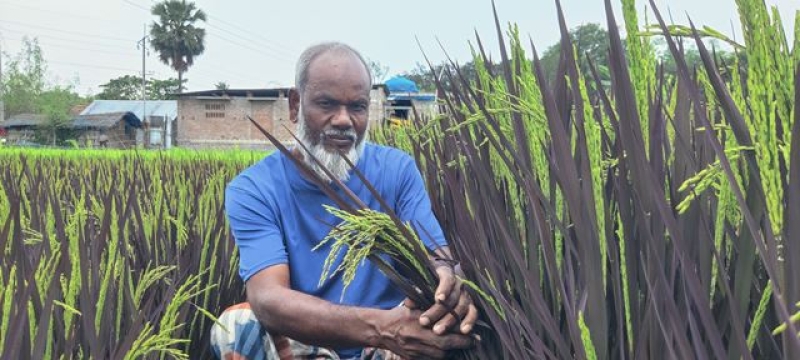- Can Dhaka’s arms recovery drive ensure peaceful polls? |
- ‘Unhealthy’ air quality recorded in Dhaka Monday morning |
- BD peacekeepers' deaths: UN chief calls Dr. Yunus, offers condolence |
- Bangladesh Plans Rockets, Satellites, and Space Industrial Park |
- India willing to work together inspired by shared sacrifices of past |
Chapainawabganj farmer creates stir with purple rice farming

Purple coloured rice plants grown by some farmers create stir in Chapainawabganj.
Nasim Mahmud
Chapainawabganj, April 20 (UNB) - In the quiet fields of Pirason village under Gomastapur upazila in Chapainawabganj, something extraordinary is happening.
Amid the lush green stretches of traditional boro rice, one farmer's field stands out—quite literally—in a striking shade of purple.
Sixty-two-year-old Robiul Islam has captured the attention of locals and passersby by cultivating a rare variety of purple-coloured rice for the very first time in the district.
Initially hesitant about planting an unfamiliar crop, Robiul was inspired by videos on YouTube showcasing purple rice cultivation in other parts of the world.
Motivated by curiosity and a sense of adventure, he placed an online order and purchased 2 kg of seeds at Tk 300 per kg.
He sowed them across 12 kathas of land near his home.
Unlike traditional green rice plants, Robiul's field is now adorned with purple stalks and leaves. The rice has already begun to flower and by the looks of the crop, he is optimistic about a healthy yield—expecting around 30 maunds (approximately 1,200 kg) per bigha.
“The cultivation method is almost identical to that of conventional boro rice. The field still requires irrigation and fertilisers, but I’ve noticed this rice faces fewer pest and disease issues,” Robiul explained.
“I developed an interest in this variety after seeing it online. I ordered the seeds from Gaibandha and started the experiment. Now, people are visiting my field every day. Many have expressed interest in buying the seeds. I plan to sell them at Tk 300 per kg. If all goes well, I believe I will make a decent profit.”
His vibrant field, nestled along a roadside lined with ordinary green paddy, has become a local attraction.
People stop in their tracks to marvel at the unexpected hue of the rice plants, and many have taken to capturing photos or simply standing in awe.
Monirul Islam, a resident of Dashimoni Kathal area in Rahanpur, said, “I pass this road every day. Ever since the plants grew tall, I’ve been amazed by the purple colour of the leaves. Now that the rice is flowering, it looks even more promising. I’ve already told Robiul bhai that I’d like to buy seeds from him for my own land.”
Golam Mostofa from Chowdala Uttar House Nagar added, “While walking down the road, I noticed the purple rice plants. I came closer for a better look and was astonished. It’s unlike anything I’ve seen before. The rice is flowering nicely—hopefully, the yield will be good too.”
Local youth Saiful Islam also shared his excitement, saying: “I’ve been watching the field from a distance for a while, but today I finally came in for a closer look. It’s amazing. If the results are good, I’ll definitely consider planting this rice myself.”
Dr Yasin Ali, Deputy Director of the Department of Agricultural Extension in Chapainawabganj, commented, “In our country, rice is grown in three major seasons.
These include local, high-yield, and hybrid varieties. Typically, rice plants are green. However, this year, a farmer from Pirason has taken the initiative to cultivate this rare purple rice on his own.”
He added, “If the resulting rice grains turn out to be purple and nutritionally beneficial, this could be a significant development. We’ve been monitoring the field since the beginning and have been providing necessary guidance to the farmer. If the yield proves satisfactory, we will consider promoting the cultivation of this variety more widely in the district.”
For now, Robiul Islam's purple paddy field stands as a testament to innovation, determination, and the willingness to embrace something new. What began as an experiment may soon bloom into a purple revolution in local agriculture. - UNB

